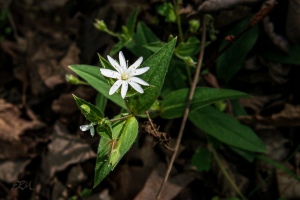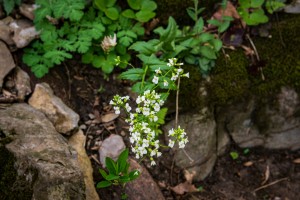 The third target of my Washington County foray with B was Trillium erectum (red trillium, wake robin; Melanthiaceae).
The third target of my Washington County foray with B was Trillium erectum (red trillium, wake robin; Melanthiaceae).
 There are 38 species of Trillium native to North America; eight of these are native to Maryland. T. erectum is found throughout New England, extending south mostly in the Appalachian Mountains as far south as northern Georgia, and there are a few populations in parts of the upper Midwest. In Maryland it’s found in scattered locations (have a look at the quad data from Maryland Biodiversity Project for details).
There are 38 species of Trillium native to North America; eight of these are native to Maryland. T. erectum is found throughout New England, extending south mostly in the Appalachian Mountains as far south as northern Georgia, and there are a few populations in parts of the upper Midwest. In Maryland it’s found in scattered locations (have a look at the quad data from Maryland Biodiversity Project for details).
 Here you can see (from the innermost parts outward) the three stigmas, six stamens, three petals, three sepals, and three bracts. Not leaves? That’s right: technically there are no above-ground leaves on trilliums. The three large structures are bracts (like the colorful parts of flowering dogwood and poinsettias). A bract is a modified leaf, found at the base of an inflorescence. However, the bracts of trilliums do engage in photosynthesis. I’m not clear, then, on why they aren’t considered leaves, but there it is. Botany is weird.
Here you can see (from the innermost parts outward) the three stigmas, six stamens, three petals, three sepals, and three bracts. Not leaves? That’s right: technically there are no above-ground leaves on trilliums. The three large structures are bracts (like the colorful parts of flowering dogwood and poinsettias). A bract is a modified leaf, found at the base of an inflorescence. However, the bracts of trilliums do engage in photosynthesis. I’m not clear, then, on why they aren’t considered leaves, but there it is. Botany is weird.

The taxonomy of the trilliums is a bit unsettled. At first, Trillium was in the Liliaceae; later it was placed in its own family, Trilliaceae; then it was moved to Melanthiaceae (bunchflower family). Now some taxonomists are putting it back into Trilliaceae.

I found 37 different common names for this species, among them bathflower, bloody nose, bumblebee-root, daffy-down-lily, herb-true-love, red-benjamin, rule-of-three, true love, wild-piny, and wood-lily. Makes me appreciate the work of Carl Linnaeus.
 [right and below]
[right and below]



































